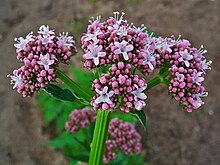Valeriana
| Valeriana | |
|---|---|

| |
| Garden valerian, Valeriana officinalis | |
| Scientific classification | |
| Kingdom: | Plantae |
| Clade: | Tracheophytes |
| Clade: | Angiosperms |
| Clade: | Eudicots |
| Clade: | Asterids |
| Order: | Dipsacales |
| Family: | Caprifoliaceae |
| Subfamily: | Valerianoideae |
| Genus: | Valeriana L. |
| Synonyms | |
|
Fedia Gaertn. | |
Valeriana is a genus of flowering plants in the family Caprifoliaceae,[1] members of which may by commonly known as valerians. It contains many species, including the garden valerian, Valeriana officinalis. Some species are native to Europe, others to North America and South America (especially in the Andes).
Fossil record[]
Fossil seeds of Valeriana sp, among them †Valeriana pliocenica, have been recovered from Late Miocene deposits of southern Ukraine, from Pliocene deposits of south-eastern Belarus and Bashkortostan in central Russia. The fossil seeds are most similar to the extant European Valeriana simplicifolia.[2]
Species[]
As of December 2020, Plants of the World Online accepts over 420 species and hybrids, including:[1]
- Valeriana alypifolia
- Valeriana aretioides
- Valeriana asterothrix
- Valeriana buxifolia
- Valeriana californica
- Valeriana celtica (Alpine valerian or valerian spikenard)
- Valeriana cernua
- Valeriana coleophylla
- Valeriana dioica (marsh valerian)
- Valeriana edulis
- (Korean valerian[3])
- Valeriana occidentalis
- Valeriana officinalis (garden valerian)
- Valeriana pauciflora
- (Pyrenean valerian)
- Valeriana secunda
- Valeriana sitchensis (Sitka valerian)
Gallery[]

Valeriana officinalis

V. montana
References[]
- ^ a b "Valeriana L." Plants of the World Online. Royal Botanic Gardens, Kew. Retrieved 2020-12-28.
- ^ The Pliocene flora of , south-eastern Belarus and its correlation with other Pliocene floras of Europe by Felix Yu. VELICHKEVICH and Ewa ZASTAWNIAK - Acta Palaeobot. 43(2): 137–259, 2003
- ^ English Names for Korean Native Plants (PDF). Pocheon: Korea National Arboretum. 2015. p. 668. ISBN 978-89-97450-98-5. Archived from the original (PDF) on 25 May 2017. Retrieved 24 December 2016 – via Korea Forest Service.
External links[]
 Media related to Valeriana at Wikimedia Commons
Media related to Valeriana at Wikimedia Commons- USDA records of the distribution of the genus in the United States
- Valeriana
- Caprifoliaceae genera
- Taxa named by Carl Linnaeus
- Fossils of Serbia
- Dipsacales stubs

